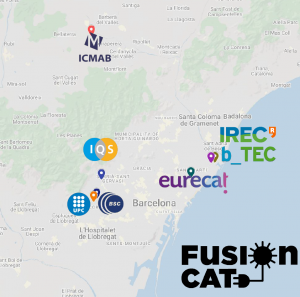
Participating institutions of the FusionCAT project
Nuclear fusion, the power source of our Sun and all the stars, is one of the few technologies which has the potential of satisfying the increasing energy demand by means of sustainable, safe and low-emission energy sources.
Significant progress in developing local fusion capabilities has been made over the past three and half years within the collaborative R&D Project FusionCAT funded by the European Regional Development Funds (ERDF) through the Pla Acció of the Research and Innovation Strategy for Smart Specialization in Catalunya, RIS3CAT. FusionCAT brought together seven partner institutions under the coordination of the Barcelona Supercomputing Center (BSC). The other members of the consortium were Foundation b_TEC Campus Diagonal-Besòs, Technology Centre of Catalonia (EURECAT), Institute of Materials Science of Barcelona (ICMAB-CSIC), Chemical Institute of Sarrià (IQS), Catalonia Institute for Energy Research (IREC), and Polytechnic University of Catalonia (UPC). In total, more than 60 people were directly involved in the project.
The main outcomes of FusionCAT include the creation of an active fusion community in Catalonia that involves leading research institutions, universities and industrial partners as well as the launch of technology transfer activities and the transfer of relevant know-how from partner institutions to industry. The focus of FusionCAT activities was on the fields where the partner institutions have well-established and internationally acknowledged expertise such as numerical modelling, analysis and design of fusion reactor components and processes, fusion reactor software development (including high-performance computing) and validation as well as diagnostic methods and instrumentation. The key fusion technologies addressed in the project included tritium technologies, high-temperature superconducting magnets and fusion reactor materials. The main assets arising from FusionCAT are skills and know-how, new diagnostic and material fabrication techniques, new and unique fusion modelling software, tools for integrated modelling as well as software licenses available as source code or remote access service licenses.
In addition to taking care of the overall coordination of the FusionCAT project, BSC played a key role in R&D activities focused on numerical modelling and new code development, combining world-class in-house high-performance computing (HPC) expertise with fusion physics and technology. Furthermore, the project provided BSC with an opportunity to train a highly-skilled workforce for fusion and HPC as well as to collaborate with leading institutions in the field both in Spain and internationally to address the computational needs of leading projects. “Within FusionCAT, our Fusion Group managed to connect some of the latest advances in HPC to fusion research in order to respond to the high computational requirements of fusion simulations,” said ICREA research professor Dr Mervi Mantsinen, FusionCAT Coordinator and leader of the Fusion Research Group of the BSC.
Among the project partners, EURECAT applied its knowledge and experience in design and optimisation through the simulation of structures and fluid dynamics systems to study various components for the IFMIF-DONES facility currently under construction in Granada (Spain) to study fusion materials under extreme irradiation conditions. It also carried out computational fluid dynamics topology optimization work for some components. EURECAT’s activities were carried out in close collaboration with IREC´s fusion technology group (bFUS). bFUS developed a new software tool that was validated and used in the DONES project later used for the design of systems and components for the IFMIF-DONES facility.
The project partner ICMAB worked on the experimental validation of a new modelling tool for high-temperature superconductors, which included among others building a new AC loss measurement system. The experiments were used to validate simulations carried out in close collaboration with BSC.
The project partner IQS developed tritium and lithium sensors and studied different fabrication methods for PbLi eutectic alloy while UPC carried out modelling of power cycles with supercritical CO2, experimental work that allowed finding materials for the development of catalytic membrane reactors for hydrogen isotope recovery and fuel clean-up systems and development of models covering a wide range of scales from molecular dynamics models up to system codes. Finally, b_TEC contributed to the FusionCAT dissemination and technology transfer activities including the organization of seminars and workshops and in networking among companies and research centers. They included European Fusion Teacher Day, organised in collaboration with the European Fusion Education Network, Fusion for Energy (F4E) and ITER to promote fusion in secondary schools.

Participants of the FusionCAT Final Community Event
At the end of the project, the partners shared their achievements with the whole community in an event where several companies and institutions related to fusion were invited to comment and discuss the latest developments as well as activities in which they are involved. The event was also attended by Manuel Moreno (CDTI), Leonardo Biagioni (F4E), Lluís Maria Tortras (ACCIÓ), Volker Naulin (EUROfusion) and Moisés Weber (CIEMAT/IFMIF-DONES) who highlighted in their presentations the different forms of collaboration and financing of projects in nuclear fusion their entities can offer. Their presentations at the event are available here. It was also a great honour that the project scientific advisors Dr. David Campbell, retired Science and Operations Director of the ITER organization, and Dr. Alfredo Portone, Analysis and Codes Group Leader at F4E, participated in the event and contributed to the round table “Fusion as a disruptive axis in the framework of the energy transition” as well as many discussions. “It was a very successful event as it allowed us not only to further nurture the local fusion community in Catalonia but also to establish new connections and engage new stakeholders in it.”, commented Dr Mervi Mantsinen expressing her satisfaction with the event.
FusionCAT with reference number 001-P-001722 has been co-financed by the European Union Regional Development Fund within the framework of the ERDF Operational Program of Catalonia 2014-2020, with the support of Generalitat of Catalonia.

